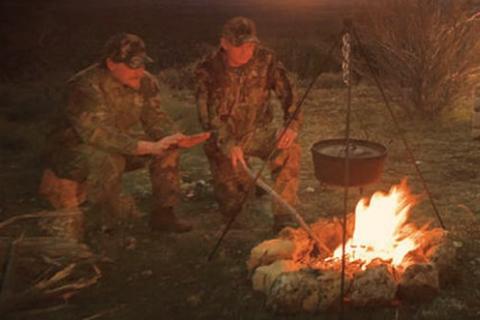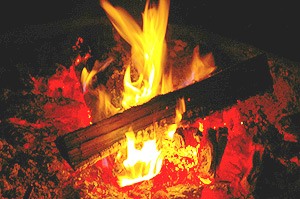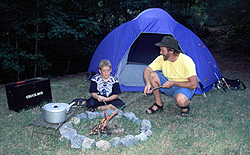
 When people think of camping, the first image that comes to mind is probably of a group of friends or family members gathered around a blazing campfire, laughing, telling stories or roasting hot dogs. The fire is not only the social hub of a campsite; it also is what keeps us warm and cooks our food.
When people think of camping, the first image that comes to mind is probably of a group of friends or family members gathered around a blazing campfire, laughing, telling stories or roasting hot dogs. The fire is not only the social hub of a campsite; it also is what keeps us warm and cooks our food.
For many people, however, building a safe, enjoyable campfire never seems to come easy. They light a match, start a small blaze and then watch as the crackling fire they had hoped for turns into a pile of scorched, smoking sticks.
Building a campfire isn't difficult, however, if you carefully follow a few guidelines. Done right, all you'll need is a single match, maybe two, to get it started.
For safety's sake, begin by choosing a safe spot for the fire. Pick a location in an open space more than 10 feet away from brush and trees. Then clear a 10-foot circle down to mineral dirt — free of dry leaves, grass, twigs and pine needles. On grassy soil, cover turf with a mound of mineral soil. If the ground is wet, build your fire on a floor of sticks or bark of dead trees. In winter, scrape away snow before laying this floor.
Next, you'll need perfectly dry fuel for making the fire. This includes three types of material: tinder, kindling and fuel. The type of tinder, kindling and fuel you use depends on the area in which you're camping. By keeping your eyes open and experimenting with native materials, you will quickly learn what to use.
Tinder is flammable material that will flare up when touched with the flame from a burning match. In areas with evergreens, look for the tiny dead twigs that seem to sprout right from the bark. The tips of dead branches of many other kinds of trees are also usable. An old mouse or bird nest can provide good tinder, too. If everything else is wet, split open a log with a hatchet, and you are pretty certain to find dry wood in the center. Cut the center part into small sticks and whittle out wood shavings for starting your fire.
We tested various types of tinder to see which burns best. Check out this video to see which one won the burning tinder test. Be sure to check out the fire tarter products at Bass Pro Shops.
Kindling is thin branches or split wood that will catch the flame from the tinder and, in turn, ignite the heavier fuel. Use pieces about the thickness of a pencil gathered on the ground or split from the interior of logs.
Fuel does the real job of providing heat or a cooking fire. This can range from thumb-thick branches for cooking a simple meal to heavy logs for keeping a fire going throughout a long night in a winter camp.
Gather a good-sized pile of each material — tinder, kindling and fuel — before you start laying your fire. One of the biggest mistakes made by greenhorns is not having enough of each to get a blaze going.
 |
| The experienced camper builds each fire to meet a particular set of needs. |
As you lay your firewood, remember that a campfire must have oxygen in order to burn. Thus you must lay the fire materials so air can easily flow through. There are several ways of doing this, including the simple lean-to fire lay. You start this fire lay by pushing a green "lean-to" stick into the ground at a 30-degree angle. Point the top of the stick in the direction from which the wind comes. Next, place a good amount of tinder well in under the lean-to stick. Then break kindling wood into short lengths and lean them carefully against the lean-to stick on both sides. Continue building up the fire by leaning thicker fuel sticks against the thinner kindling wood. Now, if your wood is dry as it's supposed to be, you can strike a match (keeping the wind at your back), cup your hands around it until it has a good flame, then apply it to the tinder and you'll have a campfire going in no time at all.
From this point, add progressively larger sticks to the fire, always making sure that enough oxygen is getting to the wood. The first reaction might be to throw on a big log right away, but this would probably just snuff the fire out. Instead, work your way up to bigger and bigger pieces of wood, maintaining the air flow underneath. Eventually the fire will be blazing strong, and you can add those larger logs.
There are many other fire lays you can use that will serve your needs just as well as the lean-to lay. Use any you might learn, but always remember to follow the three basic rules of fire-building: 1) make sure your fuel is very dry; 2) use plenty of tinder to light your kindling, and plenty of kindling to light your fuel; and 3) lay your fire materials so plenty of air can flow through and feed oxygen to the blaze.
The experienced camper builds each fire to meet a particular set of needs. For example, if you need a cooking fire, you'll be better off burning hardwoods such as oak and hickory and creating a horizontal bed of coals to cook on or over. If you're baking with a reflector oven, you need flames that radiate heat. Softwoods like pine burn hot and fast, making them ideal for this type of fire. For your evening "friendship" campfire, you will want a fire that lights up the whole circle and goes on burning throughout the evening. Stacking wood log-cabin fashion, a couple of feet high, is ideal for this.
Make your fire just large enough to meet your needs. That's one of the main secrets of proper fire building — the smaller the fire, the safer it is. When the fire is started, never leave it unattended. And when you're ready to leave, extinguish the fire by killing all embers and dousing all sticks with water. Stir and douse again.
Do these things and you will find it quite simple to enjoy the benefits of a safe, enjoyable campfire on every camping trip.
- 12276 views

